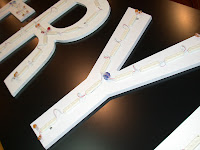LED flexible strip
is available in SMD 3528, SMD 5050 (also called tri-chip) and SMD 335
(side-emitting). It is important to understand the differences in order to
specify the correct product as over specifying could cost you or your client
more in terms of energy consumption, size of driver and product cost.
The SMD 3528 features one LED
light emitting chip per lighting source measuring 3.5mm x 2.8mm, hence the
name. They are most suitable for applications where lower luminosity is
acceptable and cost-control is important e.g. basic illumination projects, bars
& restaurants, residential use. Many of our clients choose this product to
produce decorative lighting effects beneath cabinets, counters and behind
ceiling coving.
The SMD 5050 consists of 3
chips in one housing and so emits approximately three times as much light. It
is often used for applications where higher light levels are required, e.g. external
signage applications, exhibitions, or as a light source rather than decorative.
All Spectron LED strips are
supplied in 5 metre reels with the average power consumption of our SMD 3528
being 4.8W per metre. Our SMD 5050 LED light uses extra powerful SMD 5050s that
consume up to 14.4W per metre.
Spectron LED strips are available with 30, 60, 120 and
240 no. LEDs per metre in a range of colour temperatures including cool daylight (6500K), Cool White (4300K), White (3000K), Warm White (2700K) and RGB (colour changing).
For other colour temperatures and specific requirement, please feel free to ask.
In terms of cost, the more powerful the light strip, the more expensive it will
be.
In summary, for applications requiring high luminosity or RGB
types, we recommend you opt for SMD 5050 because it is more powerful and the
cost per lumen is lower than SMD 3528. For mid-power requirements where
cost-saving is important, opt for SMD 3528 LED light strip.
For more information, please contact us on 0161 236 8828 or email sales@ledsignsandlighting.co.uk









